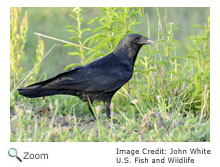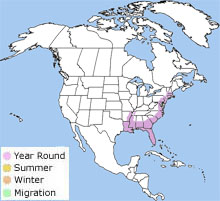Fish Crow - Corvus ossifragus |
|||||||||||
Description
Range |
HabitatThe fish crow is found along fresh and salt water lakes, rivers, beaches, marshes, and estuaries. It may also be found at the edge of forested areas near marshes and estuaries. DietThe fish crow is omnivorous. It eats turtle and bird eggs, crabs, shrimp, fledgling birds, seeds, insects, peanuts, grains, and fruit. It also eats carrion and garbage. It feeds on the ground, around the edge of the water, and in shallow water. It also forages in trees for eggs and nestlings. Life CycleThe male and the female build a nest of twigs lined with pine needles, animal hair, weeds, grass, and Spanish moss. The female lays 4-5 light blue-green eggs with brown blotches. The female incubates the eggs. The eggs hatch in 16-18 days. The male brings food to the female while she is incubating the eggs. The chicks fledge in 28-35 days. Behavior
The fish crow's range has been expanding. It has been moving up the Mississippi River and along its tributaries in recent years. |
||||||||||
Audio Credit: xeno-canto.org Mike Nelson |
|||||||||||


 The fish crow is only found in the United States. It is found along the Atlantic and Gulf Coasts. Some birds in the northern most part of its range may migrate in the fall.
The fish crow is only found in the United States. It is found along the Atlantic and Gulf Coasts. Some birds in the northern most part of its range may migrate in the fall.